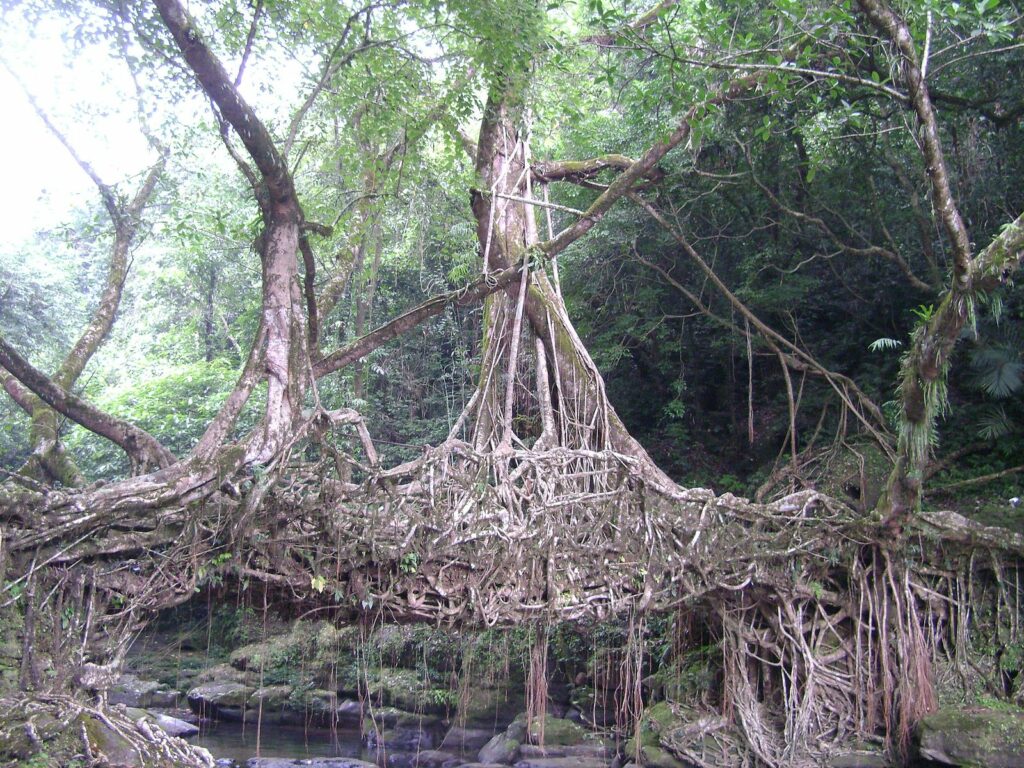Living green walls and upcycled building materials are welcome environmentally-conscious design trends, but when it comes to sustainable architecture, the living root bridges made by indigenous Khasi and Jaintia people in the north-eastern Indian state of Meghalaya have them beat by centuries.
These traditional plant-based suspension bridges make it much easier for villagers to travel to neighboring communities, markets and outlying farms by spanning the dense tropical rainforest’s many gorges and rivers.
Their construction requires patience, as builders train the aerial roots of well-situated, mature rubber fig trees into position using bamboo, old tree trunks, and wire for support, weaving more roots in as they become available.
This multi-generational construction project can take up to 30 years to complete. The carefully-tended bridges become sturdier with age, as the roots that form the deck and handrails thicken.
The village of Nongriat has one bridge that has been in place for 200-some years. An upper bridge, suspended directly overhead, is a hundred years younger.
As village head and lifelong resident Wiston Miwa told Great Big Story, above, when he was a child, people were leery of using the newer bridge, worried that it was not yet strong enough to be safe. Six decades later, villagers (and tourists) traverse it regularly.
Architect Sanjeev Shankar, in a study of 11 living root bridges, learned that new structures are loaded with stones, planks, and soil to test their weight bearing capacity. Some of the oldest can handle 50 pedestrians at once.
Humans are not the only creatures making the crossing. Bark deer and clouded leopards are also known travelers. Squirrels, birds, and insects settle in for permanent stays.
The Khasi people follow an oral tradition, and have little written documentation regarding their history and customs, including the construction of living root bridges.
Architect Ferdinand Ludwig, a champion of Baubotanik – or living plant construction – notes that there is no set design being followed. Both nature and the villagers tending to the growing structures can be considered the architects here:
When we construct a bridge or a building, we have a plan – we know what it’s going to look like. But this isn’t possible with living architecture. Khasi people know this; they are extremely clever in how they constantly analyze and interact with tree growth, and accordingly adapt to the conditions…How these roots are pulled, tied and woven together differ from builder to builder. None of the bridges looks similar.
The bridges, while remote, are becoming a bucket list destination for adventurers and ecotourists, Nongriat’s double bridge in particular.
The BBC’s Zinara Rathnayake reports that such outside interest has provided villagers with an additional source of income, as well as some predictable headaches – litter, inappropriate behavior, and overcrowding:
Some root bridges see crowds of hundreds at a time as tourists clamber for selfies, potentially overburdening the trees.
The Living Bridge Foundation, which works to preserve the living root bridges while promoting responsible ecotourism is seeking to have the area designated as a UNESCO World Heritage Site.
Related Content
1,100 Delicate Drawings of Root Systems Reveals the Hidden World of Plants
The Tree of Languages Illustrated in a Big, Beautiful Infographic
– Ayun Halliday is the Chief Primatologist of the East Village Inky zine and author, most recently, of Creative, Not Famous: The Small Potato Manifesto and Creative, Not Famous Activity Book. Follow her @AyunHalliday.
